If you recently had your dog neutered, you might be wondering when you can take him for a walk once more. After all, walking your dog is one of the finest things you can do to strengthen your relationship, keep him healthy, and enjoy the outdoors together.
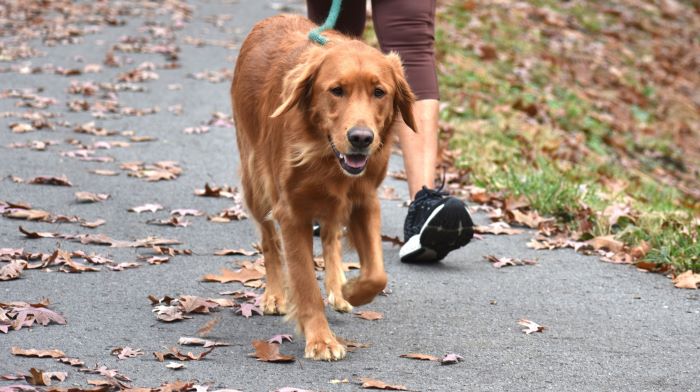
The effects of neutering your dog and the safety measures you must take while he is recovering must be understood before you grab the leash and go out the door.
The reproductive organs of your dog are surgically removed during neutering, either totally or partly. It offers several advantages for the health and temperament of your dog as well as for preventing unwanted offspring.
However, your dog needs time and attention to recover completely and prevent problems. In this article, we will answer the question of how soon you can walk your dog after neutering and give you some tips on how to make it a safe and enjoyable experience for both of you.
How Soon Should I Walk My Dog After Neutering?
Walking your dog after neutering is important for his physical and mental health.[1] Walking your dog can help him maintain a healthy weight, prevent boredom, stimulate his senses, and strengthen your bond.
In this section, we will discuss when and how to resume walking your dog after neutering based on his age, size, breed, and recovery status.
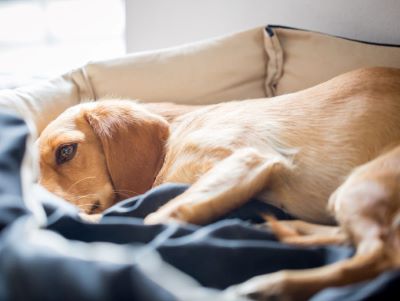
1). When to Resume Walking Your Dog After Neutering
Walking your dog after neutering is important. Walking your dog after neutering also requires some caution and patience, as your dog needs time to heal from the surgery and avoid complications.
a). The First 24 Hours: Walking your dog in the first 24 hours after neutering is not recommended. Your dog may be groggy, uncomfortable, or in pain due to the anesthesia and the surgery.
He may also have some bleeding or swelling around the incision site. Walking your dog in this period could cause him to strain his incision, increase his heart rate, or worsen his condition.
You should let your dog rest in a quiet, safe place indoors for the first 24 hours after neutering.[2]
b). The Next 10-14 Days: After the first 24 hours, you can start to resume walking your dog gradually and carefully. However, you should not walk your dog as far or as long as you normally would until he is fully healed.
You should also avoid any strenuous activity or excitement that could cause your dog to strain his incision or increase his heart rate.
The exact time and distance that you can walk your dog after neutering depends on several factors, such as your dog’s age, size, breed, and recovery status.
Generally, younger dogs recover faster than older dogs, smaller dogs recover faster than larger dogs, and some breeds recover faster than others.
You should also monitor your dog’s behavior and signs of pain or discomfort to determine how much he can handle.[3]
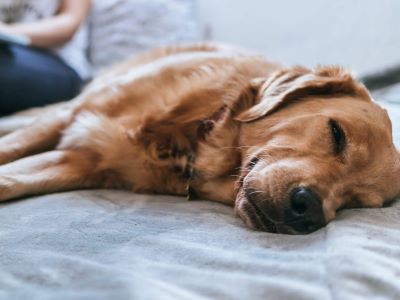
As a general guideline, you can follow these steps to resume walking your dog after neutering:
- Vet check-up on day 3 after neutering.
- Start short leash walks on day 4 or 5 and avoid other dogs or cats and rough terrain.
- Increase leash walks gradually on day 6 or 7 and avoid strenuous activity or excitement.
- Resume normal walks on day 10 after vet check-up and stitch removal and avoid off-leash areas or interactions with other dogs or cats until one month after surgery.
Recovery Period After Neutering
Neutering is a surgical procedure that requires some time and care for your dog to heal properly and avoid complications.
The recovery period after neutering can vary depending on your dog’s age, size, breed, and health status, but generally it takes about 10 to 14 days for most dogs to fully recover.[4]
During this time, you need to follow some guidelines and tips to ensure your dog’s comfort and safety. We will also suggest some low-intensity activities and exercises that are safe and fun for your dog after neutering.
1). What to Expect After Neutering in the First 24 Hours
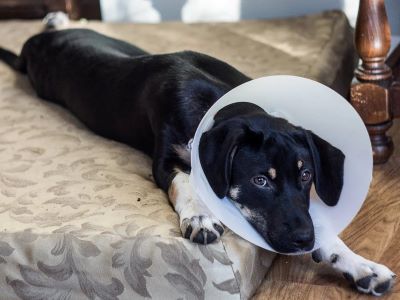
a). How Your Dog May Feel: The first day after neutering is usually the most challenging for both you and your dog. Your dog may be groggy, sleepy, nauseous, wobbly, vocal, shivering, or irritable due to the anesthesia and the surgery.
He may also have some bleeding or swelling around the incision site. These are normal reactions and should subside within a day or two.
b). Where to Keep Your Dog: You should allow your dog to recover in a quiet, safe place indoors, away from other pets and children. You should also encourage frequent movement indoors to help your dog recover from the anesthesia.
c). What to Feed Your Dog: You should offer small amounts of the food they eat regularly and water later in the evening.
Your dog may feel nauseous, and it can take up to 48 hours for his appetite to return to normal. You should not force your dog to eat or drink if he is not interested.
d). How to Check Your Dog’s Incision: You should check your dog’s incision twice daily until healed. A small amount of blood is normal immediately after surgery. Some redness and swelling of the incision is expected and normal.
However, if you notice any signs of infection, such as pus, foul odor, excessive bleeding, or fever, you should contact your vet immediately.
e). How to Prevent Your Dog from Licking His Incision: You should not allow your dog to lick, scratch, or chew the incision.
If this occurs, an Elizabethan collar (E-collar) must be used to help prevent potentially serious post-operative complications. You can purchase an E-collar from your vet or a pet store.
2.) Tips What to Do After Neutering in the Next 10-14 Days
- Restrict your dog’s activity (like running, jumping, and excessive playing).
- Keep your dog’s incision clean
- Monitor your dog’s incision for signs of complications
- Prevent your dog from licking his incision
- Give your dog medication if prescribed
- Monitor your dog’s behavior and signs of pain or discomfort
- Keep your dog away from other dogs and cats
- Schedule a follow-up visit with your vet
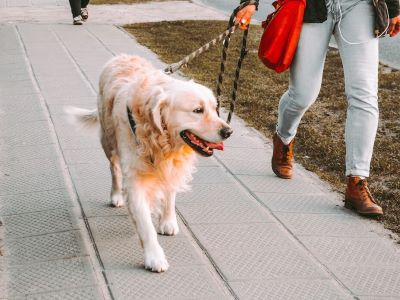
3). Activities and Exercises to Do with Your Dog After Neutering
a). Low-Intensity Activities: Walking is not the only activity that you can do with your dog after neutering. There are some other low-intensity activities that are safe and fun for your dog after neutering. These include:
- Sniffing games
- Massage and grooming
- Training and tricks
b). High-Intensity Activities: Walking is not the only activity that you should avoid with your dog after neutering. There are some other high-intensity activities that are risky and dangerous for your dog after neutering. These include:
- Running and jogging
- Playing fetch or tug-of-war
- Swimming and bathing
FAQs
How long after neutering can dogs walk?
Let your dog rest for 24 hours, then walk him on a leash for short distances and durations until he is fully healed after 10 to 14 days.
Can I walk my dog 2 days after spay?
No, let your dog rest for at least 48 hours, then follow your vet’s instructions on when and how to resume walking your dog gradually and carefully.
Can my dog walk up stairs after being neutered?
Avoid letting your dog walk up stairs until he is fully healed and cleared by your vet. If you need to let him walk up stairs, do it slowly and gently, and use a leash or a harness to support him.
Can I walk my dog 4 days after neuter?
Do not walk your dog as far or as long as you normally would until he is fully healed after 10 to 14 days. If you want to walk him 4 days after neuter, do it gradually and carefully. Keep him on a leash and avoid any strenuous activity or excitement.
Conclusion
Walking your dog after neutering is a rewarding and enjoyable activity for both you and your dog. However, it also requires some caution and patience, as your dog needs time to heal from the surgery and avoid complications.
In this article, we have discussed how soon can I walk my dog after neutering, what to expect in the first 24 hours, what to do in the next 10-14 days, and what activities and exercises to do with your dog after neutering.
Follow your vet’s advice and observe your dog’s behavior and signs of pain or discomfort. Monitor your dog’s incision and contact your vet if you notice any signs of infection or abnormality. Enjoy walking your dog after neutering and appreciate the benefits of having a healthy and happy pet.
“Neutering your dog does not mean stopping his walks, but making them safer and happier.”
References:
- Editorial Contributors. (2021a, February 19). Reasons to Spay or Neuter Your Pet. WebMD. Retrieved June 19, 2023, from – WebMD
- Post-Surgery Instructions – Animal Shelter | seattle.gov. (n.d.). Retrieved June 19, 2023, from – seattle
- Changes in the behavior of dogs after castration. (1990, February 1). Retrieved June 19, 2023, from – PubMed
- Pfaender, B. M. (2011). Intraoperative effects and post operative recovery quality after racemic ketamine or S (+) ketamine administered to male dogs undergoing elective neutering surgery. Retrieved June 19, 2023, from – University of Zurich

Dania is a dog groomer living in California, who loves styling dogs. She often uses dog accessories to keep them distracted while grooming. She is also a dog parent to a Pomeranian, Duke. It’s because of him she is always on a lookout for the best dog foods, toys, other dog accessories, and ways to keep him equipped, healthy and happy.


